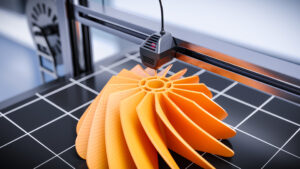
Few new manufacturing technologies have had as much impact as 3D printing. 3D printing is changing the way parts and products are manufactured. More and more companies are including 3D printing as part of their production process.
There are several different types of 3D print technology, but they all create a workpiece in similar ways. During the 3D printing process, material (usually a thermoplastic or resin) is deposited layer upon layer, based on a digital design, until the desired shape and dimensions of the finished part are achieved.
Benefits of 3D Printing
3D printing provides many benefits. It’s typically faster and cheaper to create parts using 3D printing. It provides a cost-effective way to produce prototypes, custom and replacement parts, and small to medium production runs. Parts can be manufactured locally and on demand, reducing lead times as well as shipping and inventory costs. The process is suitable for creating parts with complex geometries and intricate surface features from a wide range of materials.
One way that 3D printing is similar to other manufacturing methods is that parts often require additional finishing to smooth away burrs and other surface imperfections. Burrs are often referred to as “zits” or “blobs” and are the result of using too much filament material, high temperatures and pressures, printing a piece too fast, and other reasons. Other surface imperfections can include “stringing” (also known as oozing, whiskers, or “hairy” prints) in which small strings of material are left behind on a 3D printed part.
Abrasive Flow Machining to Polish and Deburr 3D Printed Parts
Abrasive flow machining (AFM) provides an ideal way to smooth and polish 3D-printed parts. During the AFM process, specially formulated abrasive flow media is hydraulically extruded along and through a workpiece, eroding burrs and other imperfections while smoothing and polishing inner and outer surfaces. AFM can greatly improve the function, durability, and appearance of a workpiece.
Other advantages of the AFM process include:
- Produces consistent and repeatable results – all parts are finished to the same quality standards.
- Uniform surface finishing.
- Effective for use on workpieces made from a variety of materials, including metal, plastics, ceramics, resins, and more.
- Ideal for use on 3D printed parts with complex surface features and inner surfaces.
- More cost-effective compared to other finishing methods.
- AFM doesn’t cause damage to workpiece surfaces.
Abrasive Flow Machining in Pennsylvania and Across the USA
If you’re looking for a reliable way to remove burrs and other surface blemishes from a 3D-printed workpiece, give Deburring & Finishing Technologies a call. Located just outside Pittsburgh, PA, Deburring & Finishing Technologies has been providing outstanding abrasive flow machining and abrasive flow media to companies throughout the U.S.A. since 2009. Our customers include companies in the aerospace, automotive, consumer electronics, medical device, oil & gas industry..
Custom-formulated abrasive flow media is a specialty. We can mix a batch of abrasive flow media perfect for your application.
You can contact Deburring & Finishing Technologies through our website or call us at (412) 849-1522. for more information about AFM and abrasive flow media, and get a free quote.
